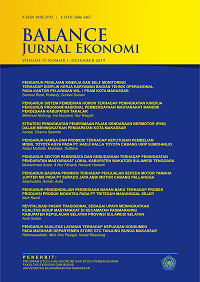Population Growth, Foreign Direct Investment, and Human Development Index on Poverty In Indonesia
DOI: https://doi.org/10.26618/jeb.v20i2.16788
Population Growth, Foreign Direct Investment, Human Development Index, Poverty.
Abstract
Poverty, as a national issue, cannot be solely resolved by the government through various development policies but also requires collective responsibility from all development stakeholders, including the community itself. The aim of this research is to analyze the influence of population growth, Foreign Direct Investment, and Human Development Index on the poverty rate in Indonesia. Secondary data from the Indonesian Central Bureau of Statistics for the period 2010 to 2022 were utilized for this study. The research population encompasses the entire Indonesian population. Non-Probability Sampling technique with a purposive sampling approach was employed to select a representative sample. Analytical methods included descriptive analysis, multiple linear regression analysis, and hypothesis testing such as t-test, F-test, and coefficient of determination to examine the statistical significance of the observed relationships. The research findings reveal that population growth and Foreign Direct Investment have a positive and significant impact on the poverty rate in Indonesia. However, Foreign Direct Investment shows a negative and significant influence on the poverty rate in Indonesia. Conversely, the Human Development Index does not exhibit a significant impact on the poverty rate. These findings contribute to a better understanding of the factors affecting the poverty rate in Indonesia and can serve as a basis for formulating more effective policies to address poverty-related issues in the future.References
Akbari, P., Panchal, M., & Undhad, D. (2019). Comparative study on investor’s preference over short term v/s long term investment. EasyChair.
Akita, T., & Kataoka, M. (2022). The Impact of the 1997 Economic Crisis on Income Inequality in Indonesia: A Two-Stage Nested Theil Decomposition Analysis (hal. 163–180). https://doi.org/10.1007/978-981-19-2968-7_6
Amalia, S., Kesuma, A. I., & Pramono, A. T. (2023). Which is more important for Indonesia: Foreign Investment, Effective Exchange Rates, or Inflation? (Study on Indonesia’s workforce over the past three decades). International Journal of Social Science and Human Research, 06(05). https://doi.org/10.47191/ijsshr/v6-i5-72
Arestis, P. (2022). UK and other advanced economies productivity and income inequality. In Capitalism: An Unsustainable Future? (hal. 25–40). Routledge. https://doi.org/10.4324/9781003266969-3
Betz, F. (2018). Capital Structures: Vectorizing the Harrod-Domar Model in Macro-Economics. Theoretical Economics Letters, 08(12), 2682–2706. https://doi.org/10.4236/tel.2018.812170
Boianovsky, M. (2018). Beyond capital fundamentalism: Harrod, Domar and the history of development economics. Cambridge Journal of Economics, 42(2), 477–504. https://doi.org/10.1093/cje/bex030
Citaristi, I. (2022). United Nations Development Programme—UNDP. In The Europa Directory of International Organizations 2022 (hal. 183–188). Routledge. https://doi.org/10.4324/9781003292548-43
Derek, T. M., Lapian, A. L. C. P., & Tumangkeng, S. Y. L. (2023). Pengaruh Pengangguran Terbuka, Pengeluaran Pemerintah, Indeks Pembangunan Manusia Terhadap Tingkat Kemiskinan di Sulawesi Utara. Jurnal Berkala Ilmiah Efisiensi, 23(9), 49–60.
Dumo, G. A., Ico, H. D., & Magpantay, E. V. (2023). Applicability of Harrod-Domar Model in Explaining Economic Growth in the Philippines. Journal of Economics, Finance and Accounting Studies, 5(3), 22–46. https://doi.org/10.32996/jefas.2023.5.3.3
Guild, J. (2023). The Indonesian state and the strategic use of foreign capital. The Pacific Review, 36(5), 1094–1119. https://doi.org/10.1080/09512748.2023.2200028
Gulo, H., Fitrawaty, F., & Arwansyah, A. (2023). Analisis pengaruh dana alokasi khusus, dana alokasi umum dan pendapatan asli daerah terhadap indeks pembangunan manusia di Sumatera Utara. SOSIOHUMANIORA: Jurnal Ilmiah Ilmu Sosial Dan Humaniora, 9(1), 59–73. https://doi.org/10.30738/sosio.v9i1.13725
Hafidz, F., Adiwibowo, I. R., Kusila, G. R., Ruby, M., Saut, B., Jaya, C., Baros, W. A., Revelino, D., Dhanalvin, E., & Oktavia, A. (2023). Out-of-pocket expenditure and catastrophic costs due to COVID-19 in Indonesia: A rapid online survey. Frontiers in Public Health, 11. https://doi.org/10.3389/fpubh.2023.1072250
Idrus, S., & Rosida, L. (2020). Poverty In Indonesia: Critical Review. Archives of Business Research, 8(6), 127–132. https://doi.org/10.14738/abr.86.8326
Kadli, S. S. H. (2023). Impact of Foreign Direct Investment on Indian Economy. International Journal of Advanced Research in Science, Communication and Technology, 29–34. https://doi.org/10.48175/IJARSCT-11306
Kholmurodov, N. Q. (2022). GENESIS AND SOCIO-PHILOSOPHICAL ANALYSIS OF THE CONCEPT OF POVERTY. Oriental Journal of Social Sciences, 02(04), 56–64. https://doi.org/10.37547/supsci-ojss-02-04-08
Lam, D. (2023). Has the world survived the population bomb? A 10-year update. Population and Environment, 45(2), 10. https://doi.org/10.1007/s11111-023-00422-7
Liang, M., Niu, S., Li, Z., & Qiang, W. (2019). International Comparison of Human Development Index Corrected by Greenness and Fairness Indicators and Policy Implications for China. Social Indicators Research, 142(1), 1–24. https://doi.org/10.1007/s11205-018-1912-5
Mejia, S. A. (2023). The economic growth effects of foreign direct investment in developing countries, 1980–2019. International Journal of Sociology, 53(4), 239–260. https://doi.org/10.1080/00207659.2023.2226484
Mota, F. D. B. P. da, & Rodrigues, P. C. da S. F. N. (2023). Foreign Direct Investment Impact on Emerging and Transition Economies: A Sustainability Perspective. European Journal of Applied Business and Management, 9(2). https://doi.org/10.58869/EJABM9(2)/01
Murali, V., & Oyebode, F. (2022). Low Income Populations. In Comprehensive Clinical Psychology (hal. 81–95). Elsevier. https://doi.org/10.1016/B978-0-12-818697-8.00135-7
Mustafa, S., & Malik, S. (2023). CAN FOREIGN INVESTMENT CONTRIBUTE TO DEVELOPMENT IN PAKISTAN? AN ANALYSIS OF ITS SIGNIFICANCE FROM PAKISTAN’S VIEWPOINT. Pakistan Journal of International Affairs, 6(2). https://doi.org/10.52337/pjia.v6i2.761
Nazzal, A., Sánchez-Rebull, M.-V., & Niñerola, A. (2023). Foreign direct investment by multinational corporations in emerging economies: a comprehensive bibliometric analysis. International Journal of Emerging Markets. https://doi.org/10.1108/IJOEM-12-2021-1878
Purwanto, S. (2019). The Long Lasting Brunt of Indonesia’s Currency Depreciation: a historical analysis on Suharto’s reign and the decades-long condemnation of low-wage workers. The George Washington University Undergraduate Review, 2(Spring 2019). https://doi.org/10.4079/2578-9201.2(2019).04
Pushpalatha, M., & Kumarasamy, T. (2022). Foreign Direct Investment from an Indian Perspective. Innovation in Economy & Policy Research, 3(2), 27–33. https://doi.org/10.46610/JEPR.2022.v03i02.005
Putra, W. (2018). Tata Kelola Ekonomi Keuangan Daerah. Cetakan Pertama. PT. Raja Grafindo Persada.
Rais, Dalimunthe, A. A., Fitrianto, A., Sartono, B., & Oktarina, S. D. (2022). Regency Clusterization Based on Village Characteristics to Increase the Human Development Index (IPM) in Papua Province. Jurnal Ekonomi Pembangunan, 21(02), 153–168. https://doi.org/10.22219/jep.v21i02.22911
Rea, D. W., & Zinskie, C. (2017). Educating Students in Poverty: Building Equity and Capacity with a Holistic Framework and Community School Model. National Youth at Risk Journal, 2(2). https://doi.org/10.20429/nyarj.2017.020201
Saragih, R. F., Silalahi, P. R., & Tambunan, K. (2022). Pengaruh Indeks Pembangunan Manusia, Tingkat Pengangguran Terbuka Terhadap Tingkat Kemiskinan di Indonesia Tahun 2007–2021. PESHUM: Jurnal Pendidikan, Sosial dan Humaniora, 1(2), 71–79.
SARGSYAN, K., & KALANTARYAN, V. (2022). THE ROLE AND FUNCTIONS OF INVESTMENTS IN CONTEMPORARY ECONOMIC SYSTEM. ALTERNATIVE, 80–86. https://doi.org/10.55528/18292828-2022.4-80
Setiawan, I., & Jamaliah, J. (2023). Analisis Kebijakan Publik Dalam Mengatasi Kemiskinan Di Indonesia. ETNIK: Jurnal Ekonomi dan Teknik, 2(5), 399–405. https://doi.org/10.54543/etnik.v2i5.188
Soegoto, H., Suryatno Wiganepdo Soegoto, & Meyer, D. F. (2022). The role of domestic investment, foreign investment and the number of Micro Small and Medium-Sized Enterprises to reduce poverty in Indonesia. Journal of Eastern European and Central Asian Research (JEECAR), 9(5), 901–913. https://doi.org/10.15549/jeecar.v9i5.1072
Sokołowska, E. (2016). Alternative Investments on Contemporary Financial Market. In The Principles of Alternative Investments Management (hal. 1–20). Springer International Publishing. https://doi.org/10.1007/978-3-319-13215-0_1
Sulasih, S., Novandari, W., & Findianingnsih, A. (2023). Dampak Pengangguran, Pendidikan dan Inflasi Terhadap Kemiskinan di Indonesia Periode Tahun 2014-2020. Disclosure: Journal of Accounting and Finance, 3(1), 1. https://doi.org/10.29240/disclosure.v3i1.6522
Vella Anggresta, Heru Subiyantoro, & Pudji Astuty. (2023). Prediction of The Global Recession’s Effects on Indonesia’s Economy in 2023. International Journal of Multidisciplinary: Applied Business and Education Research, 4(1), 1–7. https://doi.org/10.11594/ijmaber.04.01.01
Wang, X., Xu, Z., Qin, Y., & Skare, M. (2023). The role of digital technologies in firms’ performance: A panel data study on family firms and SMEs. Journal of Competitiveness, 15(2), 151–166. https://doi.org/10.7441/joc.2023.02.08












